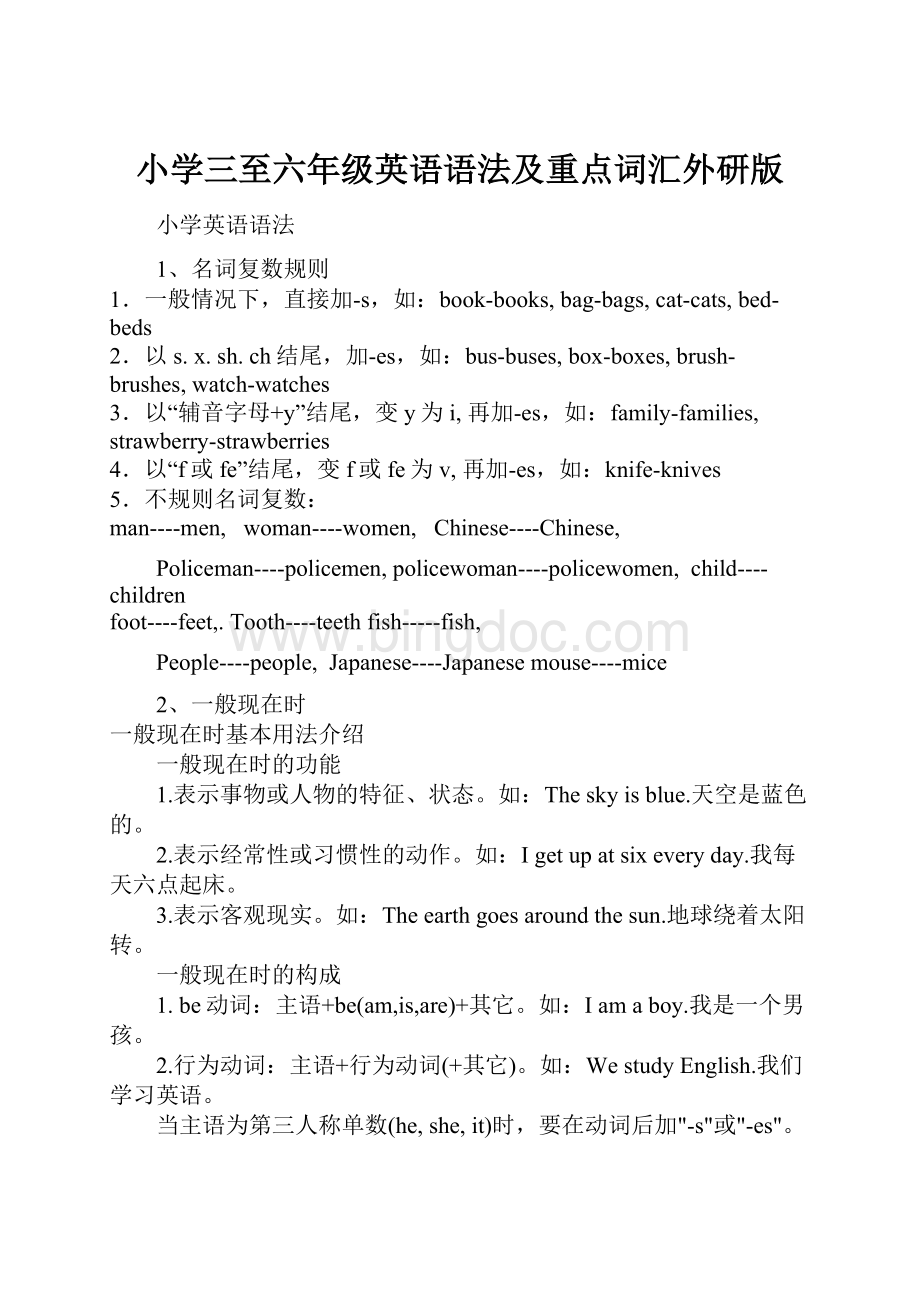小学三至六年级英语语法及重点词汇外研版.docx
《小学三至六年级英语语法及重点词汇外研版.docx》由会员分享,可在线阅读,更多相关《小学三至六年级英语语法及重点词汇外研版.docx(8页珍藏版)》请在冰点文库上搜索。

小学三至六年级英语语法及重点词汇外研版
小学英语语法
1、名词复数规则
1.一般情况下,直接加-s,如:
book-books,bag-bags,cat-cats,bed-beds
2.以s.x.sh.ch结尾,加-es,如:
bus-buses,box-boxes,brush-brushes,watch-watches
3.以“辅音字母+y”结尾,变y为i,再加-es,如:
family-families,strawberry-strawberries
4.以“f或fe”结尾,变f或fe为v,再加-es,如:
knife-knives
5.不规则名词复数:
man----men,woman----women,Chinese----Chinese,
Policeman----policemen,policewoman----policewomen,child----children
foot----feet,.Tooth----teethfish-----fish,
People----people,Japanese----Japanesemouse----mice
2、一般现在时
一般现在时基本用法介绍
一般现在时的功能
1.表示事物或人物的特征、状态。
如:
Theskyisblue.天空是蓝色的。
2.表示经常性或习惯性的动作。
如:
Igetupatsixeveryday.我每天六点起床。
3.表示客观现实。
如:
Theearthgoesaroundthesun.地球绕着太阳转。
一般现在时的构成
1.be动词:
主语+be(am,is,are)+其它。
如:
Iamaboy.我是一个男孩。
2.行为动词:
主语+行为动词(+其它)。
如:
WestudyEnglish.我们学习英语。
当主语为第三人称单数(he,she,it)时,要在动词后加"-s"或"-es"。
如:
MarylikesChinese.玛丽喜欢汉语。
一般现在时的变化
1.be动词的变化。
否定句:
主语+be+not+其它。
如:
Heisnotaworker.他不是工人。
一般疑问句:
Be+主语+其它。
如:
-Areyouastudent?
-Yes.Iam./No,I'mnot.
特殊疑问句:
疑问词+一般疑问句。
如:
Whereismybike?
2.行为动词的变化。
否定句:
主语+don't(doesn't)+动词原形(+其它)。
如:
Idon'tlikebread.
当主语为第三人称单数时,要用doesn't构成否定句。
如:
Hedoesn'toftenplay.
一般疑问句:
Do(Does)+主语+动词原形+其它。
如:
-Doyouoftenplayfootball?
-Yes,Ido./No,Idon't.
当主语为第三人称单数时,要用does构成一般疑问句。
如:
-Doesshegotoworkbybike?
-Yes,shedoes./No,shedoesn't.
特殊疑问句:
疑问词+一般疑问句。
如:
Howdoesyourfathergotowork?
3.动词+s的变化规则
1.一般情况下,直接加-s,如:
cook-cooks,milk-milks
2.以s.x.sh.ch.o结尾,加-es,如:
guess-guesses,wash-washes,watch-watches,go-goes
3.以“辅音字母+y”结尾,变y为i,再加-es,如:
study-studies
三、现在进行时
1.现在进行时表示现在正在进行或发生的动作,也可表示当前一段时间内的活动或现阶段正在进行的动作。
2.现在进行时的肯定句基本结构为be+动词ing.如:
IamwatchingTV.
3.现在进行时的否定句在be后加not。
如:
IamnotwatchingTV.
4.现在进行时的一般疑问句把be动词调到句首。
如:
AreyouwatchingTV?
5.现在进行时的特殊疑问的基本结构为:
疑问词+be+主语+动词ing?
如:
Whatareyoudoing?
但疑问词当主语时其结构为:
疑问词+be+动词ing?
如:
Whoissingingthere?
动词加ing的变化规则
1.一般情况下,直接加ing,如:
cook-cooking
2.以不发音的e结尾,去e加ing,如:
make-making,taste-tasting
3.如果末尾是一个元音字母和一个辅音字母,双写末尾的辅音字母,再加ing,如:
run-running,stop-stopping
四、将来时
1、概念:
表示将要发生的动作或存在的状态及打算、计划或准备做某事。
句中一般有以下时间状语:
tomorrow,nextday(week,month,year…),soon,thedayaftertomorrow(后天)等。
2、基本结构:
①begoingto+do;②will+do.
3、否定句:
在be动词(am,is,are)后加not或情态动词will后加not成won’t。
例如:
I’mgoingtohaveapicnicthisafternoon.→I’mnotgoingtohaveapicnicthisafternoon.
4、一般疑问句:
be或will提到句首,some改为any,and改为or,第一二人称互换。
例如:
Wearegoingtogoonanoutingthisweekend.→Areyougoingtogoonanoutingthisweekend?
5、对划线部分提问。
一般情况,一般将来时的对划线部分有三种情况。
(1).问人。
Who例如:
I’mgoingtoNewYorksoon.→Who’sgoingtoNewYorksoon.
(2).问干什么。
What…do.例如:
Myfatherisgoingtowatcharacewithmethis
afternoon.→Whatisyourfathergoingtodowithyouthisafternoon.
(3).问什么时候。
When.例如:
She’sgoingtogotobedatnine.→Whenisshegoing tobed?
6、同义句:
begoingto=will
Iamgoingtogoswimmingtomorrow.=Iwillgoswimmingtomorrow.
五、一般过去时
1.一般过去时表示过去某个时间发生的动作或存在的状态,常和表示过去的时间状语连用。
(yesterday,lastyear/week.)
2.Be动词在一般过去时中的变化:
⑴am 和is在一般过去时中变为was。
(was not=wasn’t) ⑵are在一般过去时中变为were。
(were not=weren’t)
⑶带有was或were的句子,其否定、疑问的变化和is, am, are一样,即否定句在was或were后加not,一般疑问句把was或were调到句首。
3.句中没有be动词的一般过去时的句子
否定句:
didn’t +动词原形,如:
Jim didn’tgo home yesterday.
一般疑问句:
在句首加did,句子中的动词过去式变回原形。
如:
Did Jim go home yesterday?
特殊疑问句:
⑴疑问词+did+主语+动词原形?
如:
What did Jim do yesterday?
⑵疑问词当主语时:
疑问词+动词过去式?
如:
Who went to home yesterday?
动词过去式变化规则:
1.一般在动词末尾加-ed,如:
pull-pulled, cook-cooked 2.结尾是e加d,如:
taste-tasted 3.末尾只有一个元音字母和一个辅音字母的重读闭音节,应双写末尾的辅音字母,再加-ed,如:
stop-stopped
4.以“辅音字母+y”结尾的,变y为i, 再加-ed,如:
study-studied
5.不规则动词的变化:
am,is-was, are-were, do-did, see-saw, say-said, give-gave, get-got, go-went,
come-came, have-had, eat-ate, take-took, run-ran, sing-sang, put-put,
make-made, read-read, write-wrote, draw-drew, drink-drank, fly-flew,
ride-rode, speak-spoke, sweep-swept, swim-swam, sit-sat
六、情景运用
1.问路、指路
Excuseme.Where’sthe_______,please?
Gostraighton./Turnleft./Turnright.
2.询问对方正在做什么
Whatareyoudoing?
I’m_______
Whatishe/shedoing?
He’s/She’s___________
Whataretheydoing?
They’re__________
3.询问对方是否要吃某种食物
Doyouwantsome_______?
Yes,please.No,thankyou.
4.询问对方的能力
Canyou_____?
Yes,Ican.No,Ican’t.
5.谈论将要做的事情
Whatareyougoingtodo?
I’m/We’regoingto_________
6.向别人要东西吃
CanIhavesome______?
Yes,youcan.Sorry,youcan’t.
7.介绍某人
Thisis_______
8.谈论周一至周日将要做的事
WhatwillyoudoonMonday?
I’ll_______onMonday
Willyou______onMonday?
Yes,Iwill.No,Iwon’t.
9.做天气预报
Itwillbehot/cold/sunny/windy.Itwillsnow/rain.
10.做比较
如:
SamisolderthanDaming.
七、人称代词及对应的形容词性物主代词
第一人称第二人称第三人称
人称代词:
I我we我们you你you你们he他she她it它they他们
物主代词my我的our我们的your你的your你们的his他的her她的
its它的their他们的
宾格me我us我们you你him他her她it它them他们
主格:
Iweyousheheitthey
宾格:
meusyouherhimitthem
形容词性物主代词:
myouryourherhisitstheir
名词性物主代词:
mineoursyourshershisitstheirs
八、形容词和副词的比较级
形容词比较级在句子中的运用:
两个事物或人的比较用比较级,比较级后面一般带有单词than。
比较级前面可以用more,alittle来修饰表示程度。
than后的人称代词用主格
(1)一般在形容词或副词后+er如:
tall---taller,strong---stronger,
(2)双写最后一个字母,再+er如:
big---bigger,fat---fatter,
(3)把y变i,再+er如:
heavy---heavier,early---earlier
(4)不规则变化:
如:
well--better,much/many-more,
九、缩略形式
I’m=Iamyou’re=youareshe’s=sheishe’s=heis
don’t=donotdoesn’t=doesnot it’s=itiswho’s=whois
can’t=cannotisn’t=isnotwe’ll=wewill
10、情态动词
can引导的句型:
表示有能力做某事
can后面的动词要用原形。
如:
1. What can you do?
I can sweep the floor. I can cook the meals.
2. I can water the flowers.
3. Can you make the bed?
No, I can’t.
4. Can you use a computer?
Yes, I can.
5.How can I get to Zhongshan Park?
You can go by the No. 15 bus.
重点词汇归纳:
comebacklastSunday/night/yeargohome
gotoschoolgototheparkhurryup
inahurrywaitformakealist
shoppinglisthalfakilohowmany
howmuchattheweekend.inthemorning
intheafternoontakeaphototakephotos
theBritishMuseumBigBentheGreatWall
.theLondonEyegiveoutbecareful
toomanyrunfastplayfootball
halfpastsevengetupsitdown
standupdomorningexercisesplaychess
onthefarmalldayofcourse
gooutsayhellotoplaybasketball
playtabletennismanyyearsagotenyearsago
threedaysagoliveinalotof=lotsof
watchTVhowabout=whatabouttalkabout
foreignlanguagestudy/workhardanEnglishteacher
aChineseteacherbybus/plane/car/train/ship/bike
.English/Chinesefoodatschool/.athomeatthelibrary
librarycardfindoutbegoodat
lookathave/hasgotintheeastofChina
inthewestofChinainthesouthofChina
inthenorthofChinaeveryyear/daysendanemail
agoodidealist
如有侵权请联系告知删除,感谢你们的配合!